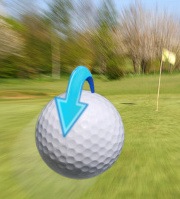
Backspin is a golf term that refers to the rotational spin imparted on the golf ball when struck with a club. It is the opposite of the ball's forward spin, creating a reverse rotation as it travels through the air.
When a golf ball is hit with backspin, it experiences several effects:
- Lift: Backspin creates lift, allowing the ball to stay airborne for a longer period. The upward force generated by the backspin counteracts the downward force of gravity, resulting in a higher trajectory and increased carry distance.
- Stability: The backspin imparts stability to the ball's flight. It helps counteract the influence of factors like wind, which can affect the ball's trajectory. The backspin creates gyroscopic stability, helping the ball maintain a straighter flight path.
- Stopping Power: Backspin is essential for shots where the golfer wants the ball to stop quickly upon landing, such as approaches to the green. The backward rotation creates friction between the ball and the ground, reducing the ball's roll after it hits the surface.
- Control: Backspin provides golfers with better control over their shots. With proper backspin, players can manipulate the ball's flight path, control the distance it carries, and aim for specific landing spots on the green. It allows for more precise shot-making.
Backspin is primarily achieved through a combination of factors, including clubface loft, clubhead speed, and the downward angle of attack at impact. Hitting down on the ball with a clean, descending strike helps generate the desired backspin.
Golfers can control the amount of backspin they produce by selecting the appropriate club, adjusting their swing mechanics, and focusing on making clean contact with the ball. Additionally, using a high-quality golf ball with design features optimized for spin can also enhance backspin performance.
It's important to note that backspin is not always desired for every shot. Different shots and situations call for varying levels of spin, and golfers must develop the skill to adjust and adapt their shots accordingly.
A golf ball rotating opposite to the direction it is flying is said to have backspin. This spin is created by the golf club’s loft as well as its grooves, which grab the surface of the ball and amplify the effects of loft. The more loft a club has, the more backspin it will impart. For example, a pitching wedge shot will spin more rapidly than one hit with a driver.
A high backspin rate causes the golf ball to fly higher and stop more quickly on landing.





